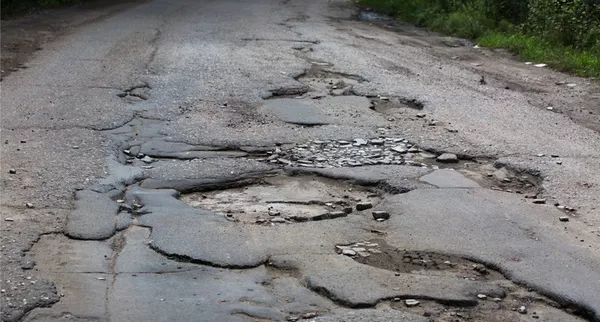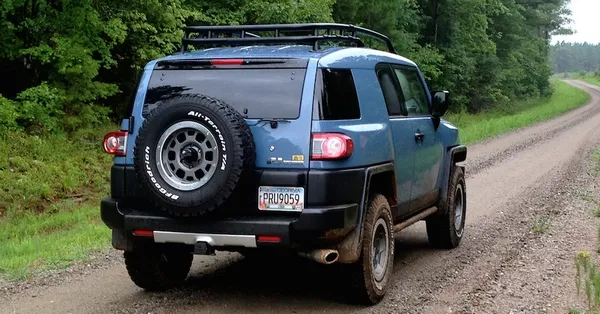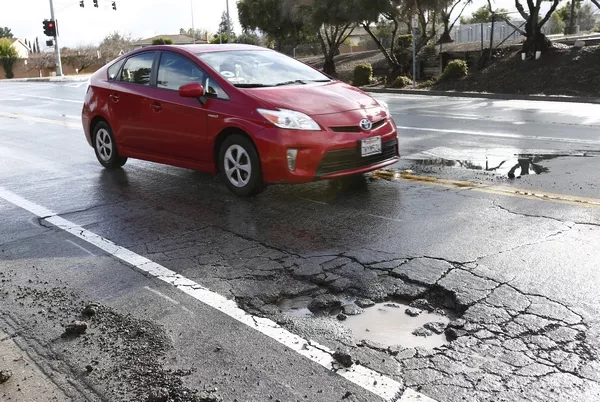Drivers in the Philippines have got accustomed to potholes. They are large rough holes in the surface of a road that are formed by traffic and bad weather. These potholes make roads become ugly and bumpy, which can damage vehicles accidentally passing through them.
The soil layer beneath a road not hard enough is one of the main reasons why potholes are created. When these holes are under firm pressure of vehicles day by day and the road soaks in the rainwater, its surface will be damaged more seriously with cracks. Gradually, potholes becomes worse and worse.

Potholes are large rough holes in the surface of a road that are formed by traffic and bad weather
1. What damage potholes can cause to your car?
Potholes can cause damages to your car at different levels. It can just be a slight damage that hardly harms your car. It can be a serious damage that costs you an arm or a leg for repair. The level of damage depends on two main things:
- The speed of your vehicle;
- The depth of potholes.
Oblivious Drivers Hit Massive Pothole
The higher the speed your car reaches and the greater the depth of pothole is, the more serious the damage to your vehicle is. There are some parts of your car being most inflicted by potholes.
1.1. Suspension
When your car hits potholes unexpectedly, many vital parts of the suspension are affected adversely. Steering rack, bearings, ball joints, tie rods and other parts can be harmed in a serious way, which leads to many problems. Here are some problems that you might face:
- Your vehicle can be out of alignment, steering wheel is not in the right position.
- Struts, shocks, ball joints no longer work correctly. There are some strange noises and vibrations created. You can also lose control of steering and your riding is not in good condition.
1.2. Underside
The distance from the underside of a car to the road is very short. Then this is one of the parts that is affected most when your vehicle passes through wide and deep holes on the roads.
A hit with pothole can form some small cracks or holes on the surface of your car’s underside, causing fluid leaks and other issues.
Pothole glut damaging cars
1.3. Tires
Another part that is exposed to damage by potholes is your car’s tires. A strong hit with pothole can distort the metal edge of a wheel onto which the tire is fixed. This distortion then can make the seal between the tire and the metal edge less tight. Air will have more chances of getting out and you will eventually get a flat tire. Cars with rims made from aluminum are most damaged in this situation. Besides, potholes can also cause bulges and blisters on your tire.
1.4. Exhaust System
Exhaust system is also on the list of parts that are most vulnerable to a hit with pothole. A symptom of exhaust trouble is unusual noises emitted from your car’s exhaust.
2. How to avoid hitting potholes while driving?
Even though you drive very carefully, hitting potholes sometimes is unavoidable. What you need to do is making your chances of driving through them to be as fewer as possible. Here are some tips you can follow if you don’t want to enjoy smooth drive:

Cleaning your headlights and windshield is a way to avoi hitting potholes
2.1. Keep your headlights and windshield clean
One of the most simple tips is cleaning your headlights and windshield. Although this is kind of obvious practice, but some drivers still intend to ignore and neglect it. You can have a better view of what is on the way to be able to avoid obstacles in time if your windshield is as clean as a whistle. When driving at night, your headlights play an important role in helping your view not be limited by the dark then you can see everything clearer.
2.2. Watch the vehicles running ahead of your car
Pay attention to vehicles in front of you. If they suddenly change their direction, there might be potholes on the road and it would be better for you to follow them. However, if you see the car in front of you bounce unexpectedly, you should avoid that direction as well. Best option is to keep the car running at fair speed for better interaction on the go. You should maintain a reasonable gap between your car and the car in front of you as well.
2.3. Drive carefully on driving through gravel roads
Gravel roads is unpaved and surfaced with many small stones. These roads are well known for having a lot of potholes. because the soil beneath is not hard and regularly washed away. When you meet this kind of road, you should pay attention very much onto driving. Let’s observe carefully and be ready to avoid potholes anytime, particularly at night.

Gravel roads usually contains a lot of hidden potholes
2.4 Drive at low speed if you run on a wet road
While gravel roads are notorious for having a lot of potholes, wet roads are well known for covering potholes. These holes can filled up with water when it rains heavily. It is difficult for car drivers to see a pothole that is full of water. In this case, you should decrease your speed and keep observing continuously.
2.5. Maintain good tire pressure
Don’t forget to inflate your tires because it will protect your car from being affected by potholes. This can be an efficient buffer between your car’s rims and a road depression.
>>> More tips to take care of car tires:
3. What you need to do when driving on bumpy roads
Sometimes, it is impossible to drive away from a pothole. If you can’t avoid it, you should try to keep the damage from them as less as possible. Let’s remember these tips when you drive through potholes:
3.1. Decrease your speed before hitting it
As we mentioned above, the faster your car runs, the more serious the damage is when you hit a pothole. Then, if you want your car to run a smooth and less dangerous drive, you should slow it down on driving through them.

Slow down before driving through pothole will help minimize the impact
3.2. Don’t brake directly over it
If you don’t want your car run deeper inside the hole, try not to push the pedal hard. Braking directly over a pothole can make your car damaged more seriously.
3.3. Keep everything under control
Always remember to hold your steering wheel tightly then you can take control of it better when running through any potholes. You shouldn't change the direction so as to keep your vehicle go straight through the hole, which will keep your wheel and tire safer.











